Six-String Samurai is a celluloid celebration of audacity, one due not only to the rock ‘n’ roll madness of its quirky story but the daring of first-time filmmakers. Wrap that up in a willingness to make a movie that might not appeal to a broad audience, and Six-String Samurai becomes a strange ode to the punk rock potential of motion pictures—those dreams which only come to life when someone dares record them.
Released 25 years ago, Six-String Samurai rapidly found a home down the rabbit hole of midnight movies. Before streaming made almost everything accessible to anyone at any time, offbeat flicks the mainstream ignored often ended up playing during late-night hours at local movie theaters. The 2005 documentary Midnight Movies: From the Margin to the Mainstream wonderfully details the evolution of this niche. It’s that curious place where movies like Eraserhead (1977), El Topo (1970), Pink Flamingos (1972), and The Rocky Horror Picture Show (1975) found their audiences.
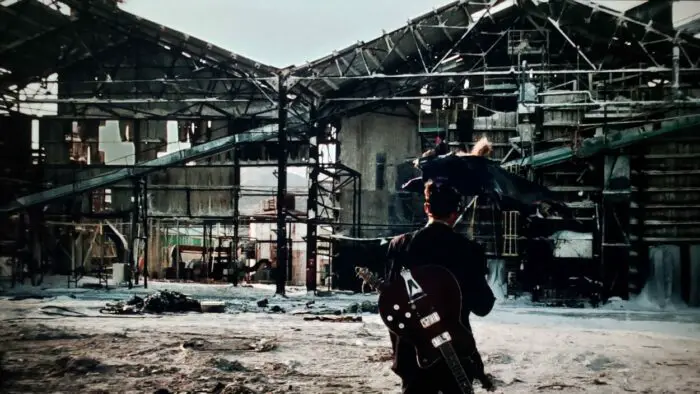
Six-String Samurai tells the tale of a guitar picking swordsman crossing the wasteland in a post-apocalyptic United States. An alternate history sets the scene with Soviet Russia dropping nukes in 1957. In the aftermath, only Lost Vegas remains as the last bastion of hope and freedom. For forty years, Elvis reigned there as king, but with his demise, the radio sends out word, “Vegas needs a new King!” and all the rock ‘n’ roll wannabe rulers are hoofing it to vie for the throne. Even Death is said to be headed for Lost Vegas.
The central character is Buddy played by Jeffrey Falcon. Along the way he picks up a tragically orphaned child played by Justin McGuire. Despite being an all-around loner, Buddy just can’t shake the Kid, and the two embark on an adventure vaguely akin to The Wizard of Oz.
Dressed in a tattered black suit and wearing thick black rimmed glasses, Falcon bears a striking resemblance to Buddy Holly. And that’s not by accident. Various characters throughout, mainly the other sword wielding dualists, could all be considered symbolically linked to different genres and rock legends. There’s a character indicative of Ritchie Valens, an outlaw country themed costume, even a mariachi-inspired individual, perhaps a nod to Robert Rodriguez’s cult classic El Mariachi (1992).
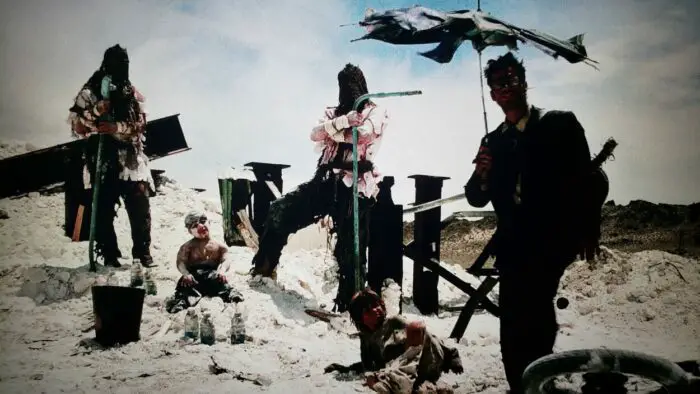
Six-String Samurai is one of those films which wears its influences loud and proud. The most obvious being Japanese chambara films like Akira Kurosawa’s Yojimbo (1961), but there are shades of the six Lone Wolf and Cub movies as well. Not to mention spaghetti Westerns such as Sergio Leone’s A Fistful of Dollars (1962) and Tonino Valerii’s My Name is Nobody (1974). All in all, the movie could be considered a Mad Max samurai spaghetti western.
At the same time, Six-String Samurai is, like a lot of media from the 1990s, a touch satirical. The postmodern sarcasm that saturated the decade is present here. For instance, depictions of the quintessential nuclear family—no pun intended—indicative of 1950s sitcoms like Leave It to Beaver are here twisted into insane cannibals.
The stylization of various parts and roles speaks to the visual strength throughout Six-String Samurai. Yet, it’s only part of the picture. Consider the sunset saturated scene featuring Buddy practicing martial arts atop desert dunes. It’s a masterful display of cinematography as a color gradient of warm tones fills the screen in every shade of orange, yellow, and red. Furthermore, some shots are downright iconic. They look perfect for the type of comic book adventure Six-String Samurai calls to mind. It’s easy to envision panels by Bilquis Evely, or the artwork of Jean Giraud (a.k.a. Mœbius), especially his “Blueberry” comics with their anti-hero revisionist Western elements. Plus, Rafael Grampá, whose graphic novel “Mesmo Delivery” kept coming to mind when I rewatched Six-String Samurai.
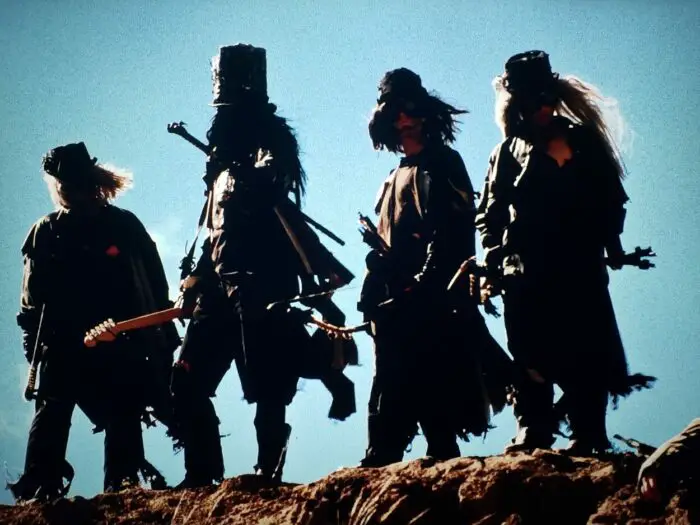
What sells things even further, especially the combat, is some stellar editing by James Frisa. Six-String Samurai is cut in ways that change the pace of the picture, applying the brakes or adding gas when necessary. Fights become frenzied, but never lose focus. No edit looks oddly clipped which allows the movie to play smoothly instead of awkwardly jumping around. It’s no wonder Six-String Samurai won awards for excellence at the Slamdance film festival for editing and cinematography.
The movie is a collection of grand vistas and tight action scenes. Writer-director Lance Mungia knows when to let the landscape express the story, but also when to pull in for the kill. Windmills in the distance provide testament to high-tech survivors, but when the dangerous denizens of that realm emerge, the camera comes in close to witness Buddy slicing them to ribbons. Of course, that’s when everything works.
Ambitious stylization can only distract from low-budget limits to a degree. For instance, a postapocalyptic setting and clever use of shadows can only disguise the quality of costumes to a certain extent. Yet, when Russian soldiers charge with what are clearly tin foil wrapped floppy cardboard bayonets, a different kind of charm takes over.
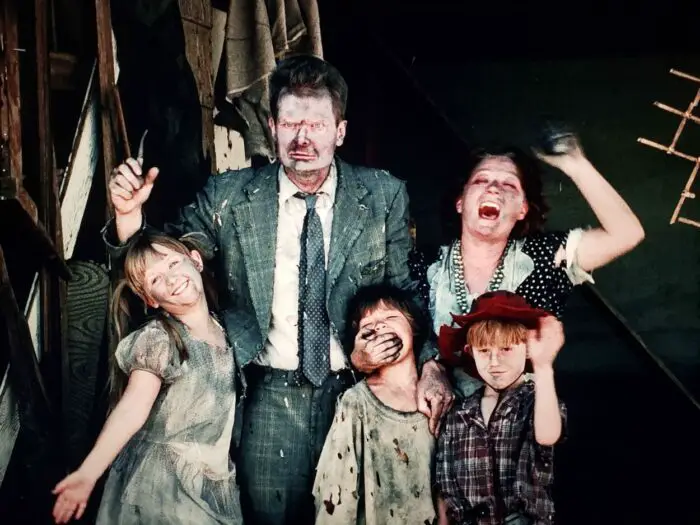
Vinegar Syndrome released a 4K Ultra HD remaster of Six-String Samurai not too long ago. Included with it are commentary tracks and a documentary Vegas Needs a New King: The Making of Six-String Samurai. Those detail an inspiringly ambitious production.
In the final days of film school, Lance Mungia decided on a bizarre movie for his final project. He and an associate went nearly $50,000 into debt to finance the shoot. Using the limited success of his short film A Garden for Rio, Mungia managed to finagle a free camera and film as well as wrangle a volunteer crew working for free on weekends. Six-String Samurai then began shooting in Death Valley on rolls of expired Fuji film stock.
Things did not always go smoothly. For instance, the documentary recounts them filming without permits, consequently needing to hide from rangers, who eventually kicked them out of the desert for trespassing. But not before they got some amazing shots. Then there’s the anecdote about how a van full of crew members arrived, and the second the burning desert air hit, they slammed the side door shut, hightailing it out of there without ever leaving the vehicle. Every weekend fresh faces arrived because the aptly named Death Valley routinely inspired crew members to quit.
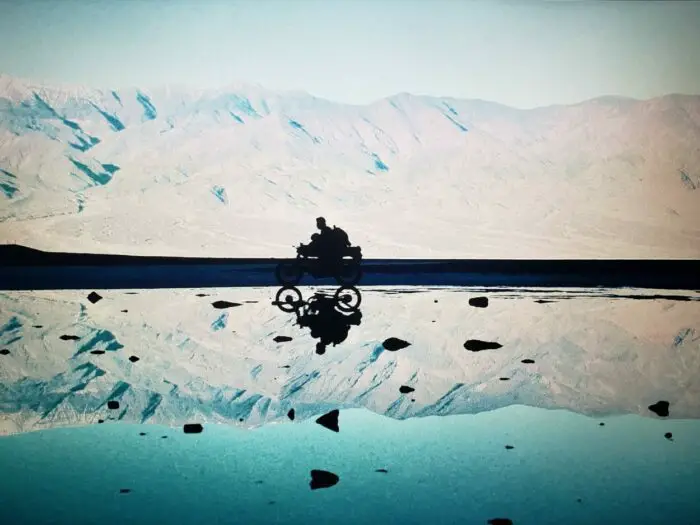
Still, the filmmakers remained determined. They managed to cobble together enough for a trailer which they shopped around as proof of concept. That got them the attention of producers Leanna Creel and Michael Burns.
From there things became more serious, but throughout the production a sense that anything was possible remained. The commentary tracks and testimony in the documentary reveal what mattered most was getting the movie made. Yes, they wanted to make the best picture possible, but they also just wanted to make a movie. The joy of creation abounds across various anecdotes as everyone came together to make Six-String Samurai happen.
No one ever worked one job. Jeffrey Falcon did fight choreography and production design while making costumes in spare moments. Multiple people took over the role of Death. Editor James Frisa filled the role of a comically bizarre bartender. Even the Red Elvises who did most of the soundtrack appear as a group of musical assassins. In many ways, Six-String Samurai is a testament to the collaborative nature of cinema — no one can do it alone.
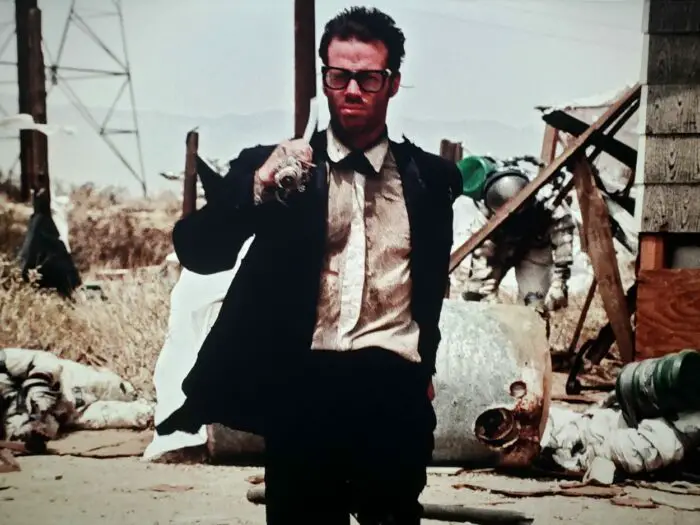
And at long last, with a feature length film finished, Six-String Samurai premiered at the Slamdance Film Festival. From there, in the early days of the internet, rumors spread of this slick, quirky indie film. Sites like Ain’t It Cool recounted the wonderful weirdness of Lance Mungia’s comedic epic. Hype on the Hollywood Stock Exchange then helped lift Six-String Samurai to the attention of Chris Blackwell. The founder of Island Records, who released albums by Bob Marley, as well as Island Pictures which produced the cult classic The Harder They Come (1972), Blackwell’s newly established Palm Pictures snapped up Six-String Samurai.
Everything seemed to be falling into place. However, Mungia shares a heartbreaking story in the documentary Vegas Needs a New King. He went to the theater opening night, and found lines of people waiting to get in. At first thrilled by the prospect of his film being a breakout sensation, he soon realized the epic attendance was for Rush Hour (1998). Opening that same day, the Jackie Chan, Chris Tucker action comedy overshadowed Six-String Samurai. Yet, the movie never died.
Instead, Six-String Samurai settled into the midnight movie scene. There to acquire a quiet cult following. Perhaps not something as epic as other legends, but a respectable fanbase nonetheless. While it definitely remains a film widely unfamiliar to even the most devoted collectors of obscure media, Six-String Samurai lives in the hearts of many.

Now, it’s impossible to talk about this movie without mentioning the soundtrack. Composed almost entirely of music by the Red Elvises, Six-String Samurai is a rockabilly romp from start to finish. Lance Mungia even spoke on the commentary about orchestrating scenes to specific songs. Something editor James Frisa nails perfectly with physical hits accompanying musical beats and shot shifts dancing around in time to tunes. The Siberian surf rock flavor of the Red Elvises lends a unique quality to Six-String Samurai no other film could mimic. However, if they bring the funk and the fun, composer Brian Tyler is the other essential part of the puzzle.
His contributions give the movie gravity when necessary. Such instances musically allow satire to shift into sincerity and seriousness. Yet, all the while, things remain sonically connected stylistically. It’s hard to tell when the Red Elvises give way to Tyler and vice versa. To this day, the musicians, who still tour, are often asked why they don’t play “On My Way to Vegas” live. And they’re forced to enlighten fans, it’s because the movie’s closing song isn’t one of theirs, it’s Brian Tyler’s. As such, it’s no wonder he’s gone on to score seven of the Fast and Furious films, multiple Marvel movies (the fanfare at the start of all is his), several television series, and numerous video games like Assassin’s Creed IV: Black Flag.
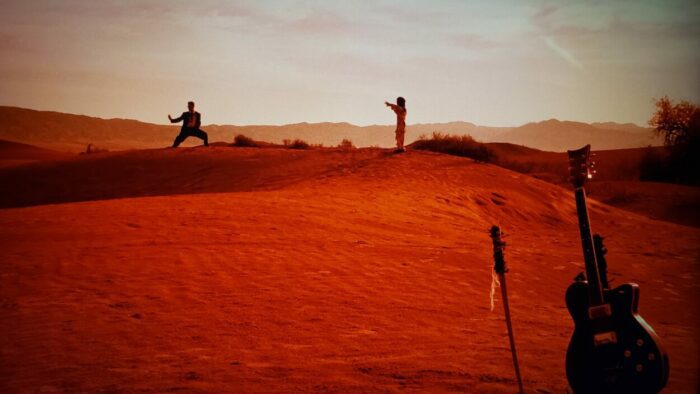
Still, Six-String Samurai isn’t for everyone. The choice to do all the audio in post-production leaves sounds and voices may hit ears oddly. While this is meant to mimic Asian action films, it’s easy to imagine folks finding it off putting. The dialogue isn’t always a strength, though there are some clever quotable lines. The Kid can be annoying. However, a veteran star of 17 Hong Kong action flicks, Falcon’s full-bodied performance is at times astonishing, such as when he bounds up a steep hill in a way that would seem to require wires but which the low-budget production never used.
Peter Stack wrote for the San Francisco Chronicle, “If the film didn’t have an underlying intelligence, it would soon be irritating — it’s too cartoonish and one-dimensional. But Falcon, an ace martial-arts practitioner, is dazzling as the nerdy main attraction, equally adept at sword fighting and guitar picking.”
Laurie Stone penned a very different opinion for the Village Voice writing, “There’s one charming sequence, with vaudeville grace and tragicomedy worthy of Beckett, but the rest of the film, even with startling visual effects and some impish humor, is repetitious and derivative, playing like an endless commercial for bullet-hole chic.”

Personally, I think the truth is somewhere in the middle. Having watched Six-String Samurai about three times in the last month, it definitely grows on a person. Its premise is excellent and manages to world build simply through implicative visuals. The soundtrack can keep an audience interested even when repetitious scenes of wandering the wasteland play out. Plus, Six-String Samurai wasn’t made to appeal to any demographic or following the guidance of an algorithm. It was a fever dream a few filmmakers determined to share with the world, and like Buddy on the way to Lost Vegas, nothing was going to get in the way.



